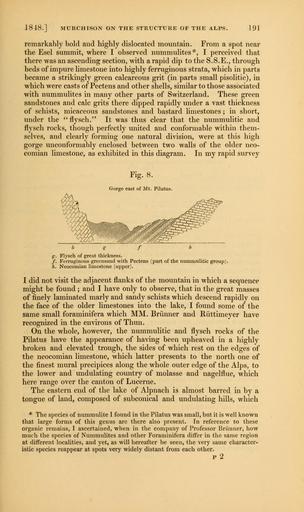MAKE A MEME
View Large Image

| View Original: | The_Quarterly_journal_of_the_Geological_Society_of_London_(12645132115).jpg (1188x2004) | |||
| Download: | Original | Medium | Small | Thumb |
| Courtesy of: | commons.wikimedia.org | More Like This | ||
| Keywords: The Quarterly journal of the Geological Society of London (12645132115).jpg 1848 MURCHISON ON THE STRUCTURE OF THE ALPS 191 <br> remarkably bold and highly dislocated mountain From a spot near <br> the Esel summit where I observed nummulites I perceived that <br> there was an ascending section with a rapid dip to the S S E through <br> beds of impure limestone into highly ferruginous strata which in parts <br> became a strikingly green calcareous grit in parts small pisolitic in <br> which were casts of Pectens and other shells similar to those associated <br> with nummulites in many other parts of Switzerland These green <br> sandstones and calc grits there dipped rapidly under a vast thickness <br> of schists micaceous sandstones and bastard limestones ; in short <br> imder the 'flysch It was thus clear that the nummulitic and <br> flysch rocks though perfectly united and conformable within them- <br> selves and clearly forming one natural division were at this high <br> gorge unconformably enclosed between two walls of the older neo- <br> comian limestone as exhibited in this diagram In my rapid survey <br> Fig 8 <br> Gorge east of Mt Pilatus <br> g Flysch of great thickness <br> / Ferruginous greensand with Pectens part of the nummulitic group <br> b Neocomian limestone upper <br> I did not visit the adjacent flanks of the mountain in which a sequence <br> might be found ; and I have only to observe that in the great masses <br> of finely laminated marly and sandy schists which descend rapidly on <br> the face of the older limestones into the lake I found some of the <br> same small foraminifera which MM Briinner and Riittimeyer have <br> recognized in the environs of Thun <br> On the whole however the nummulitic and flysch rocks of the <br> Pilatus have the appearance of having been upheaved in a highly <br> broken and elevated trough the sides of which rest on the edges of <br> the neocomian limestone which latter presents to the north one of <br> the finest mural precipices along the whole outer edge of the Alps to <br> the lower and undulating country of molasse and nagelflue which <br> here range over the canton of Lucerne <br> The eastern end of the lake of Alpnach is almost barred in by a <br> tongue of land composed of subcorneal and undulating hills which <br> The species of nummulite I found in the Pilatus was small but it is well known <br> that large forms of this genus are there also present In reference to these <br> organic remains I ascertained when in the company of Professor Briinner how <br> much the species of Nummulites and other Foraminifera differ in the same region <br> at different localities and yet as will hereafter be seen the very same character- <br> istic species reappear at spots very widely distant from each other <br> p2 35268835 109512 51125 Page 191 Text v 5 http //www biodiversitylibrary org/page/35268835 1849 Geological Society of London NameFound Foraminifera NameConfirmed Foraminifera EOLID 2869058 NameBankID 5953016 NameFound Nummulites NameConfirmed Nummulites EOLID 6817785 NameBankID 3399048 NameFound Pilatus Biodiversity Heritage Library The Quarterly journal of the Geological Society of London v 5 1849 Geology Periodicals Smithsonian Libraries bhl page 35268835 dc identifier http //biodiversitylibrary org/page/35268835 smithsonian libraries Information field Flickr posted date ISOdate 2014-02-20 Check categories 2015 August 26 CC-BY-2 0 BioDivLibrary https //flickr com/photos/61021753 N02/12645132115 2015-08-27 10 59 22 cc-by-2 0 PD-old-70-1923 The Quarterly journal of the Geological Society of London 1849 Photos uploaded from Flickr by Fæ using a script | ||||